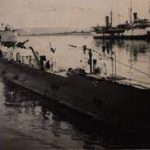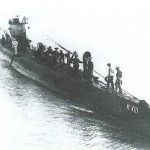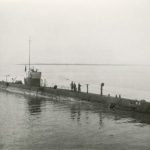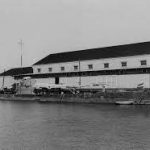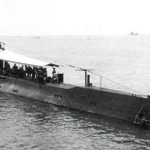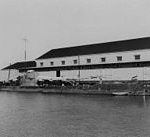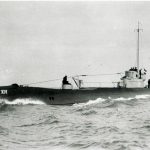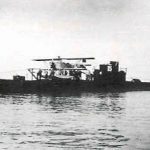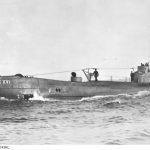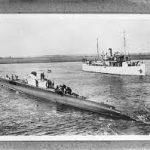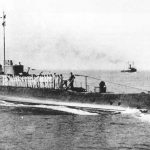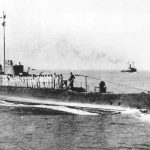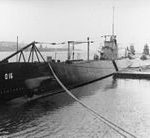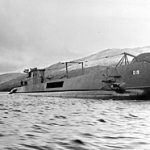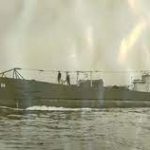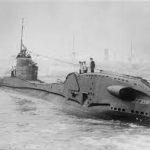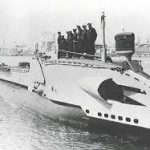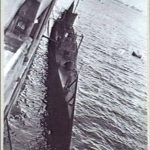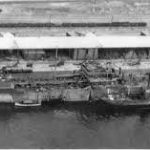The submarine division of the Royal Netherlands Navy (RNN) was launched in 1906. At the start of WWII, it had approx. 25 submarines in service, with 15 boats deployed in the Netherlands East Indies (NEI).
They included the: K-VII (507 tons), K-VIII, K-IX, K-X (all 521 tons), K-XI, K-XII, K-XIII (all 611 tons), K-XIV, K-XV, K-XVI, K-XVII, K-XVIII (all 771 tons), O-16 (896 tons), O-19, O-20 (both 998 tons).
After the Japanese occupation of the NEI, the surviving seven submarines (K-VIII, K-IX, K-XI, K-XII, K-XIV, K-XV, O-19) escaped to either Australia or Ceylon (now Sri Lanka). After a naval reorganization, it was decided that the majority of these ex-NEI submarines would concentrate and operate from Australia. Eventually, all seven boats would be sent in the South-West Pacific Area. In 1944, they were reinforced by two, newer submarines (Tijgerhaai, Zwaardvisch) that had been bought from the British.
The above images are from the submarines used by the RNN. Zwaardvisch and Tijgerhaai, were temporarily transferred by the RN to the RNN. The last three pictures are from the depot ships that supported the submarines. Images are from the RNN and the National Archives.
With the permission of the author, this overview is mainly a compilation from the relevant abstracts taken from the book Allies in a Bind by Dr Jack Ford. His book has a large number of footnotes to original documents.
Dutch submarines supported the British war effort in the East.
With the unprecedented advance of the Japanese invasion force throughout SE Asia the Allied Forces established in January 1942 the American-British-Dutch Australia (ABDA) Command.
The Dutch contributed their Glenn Martins and Dornier’s flying boats as well as their navy including their submarines. They were deployed to support Malaya, British Borneo, Singapore and the Philippines.
The submarines played a critical role in the battles that followed as it were only submarines that had an ability to thwart the overwhelming Japanese airpower deployed to protect their invasion convoys.
The Dutch submarines included in the early battles were the K XII, K XIII, K XIV, K XVI, K XVII, and the O 16 and O 20.

During the battle of Malaya, a Royal Netherlands Navy (RNN) hunting group of three submarines sailed north to attack the Japanese landing at Kota Bahru. The RNN submarine group had success off Malaya. K-XII sank the transport Toro Maru (1,939 tons) off Kota Bahru on 12 December. O-16 attacked Tosan Maru (8,666 tons), Sakina Maru (7,170 tons), Ayato Maru (9,788 tons) and Asosan Maru (8,812 tons). All were severely damaged. The next day K-XII sank the naval tanker Taisin Maru (3,525 tons). This was the first Japanese naval loss of the Pacific War.
The small number of Dutch submarines sank more Japanese ships in the first few weeks of the war than the British and American navies combined. This earned its Admiral Conrad Helfrich his nickname Ship-a-day Helfrich.
K-XIII had no success. 0-16 was lost to an unmarked British minefield in front of the Malayan coast on 13 December. Only one person on board managed to save himself and reach an uninhabited island while swimming (35 hours). It was located in 1995 near the island of Tioman, but by 2015 it was no longer there, looted for their scrap iron.
O-20 was sent as to replace O-16. A Japanese destroyer sank it on 19 December 1941. The commander and six crew members were killed. The remaining 32 crew members were picked up by a Japanese fighter the next day and taken prisoner of war.
On December 20, 1941, the submarine K XVII, on its way home to the naval base in Singapore, near Tioman in the South China Sea, ran into a newly laid Japanese minefield, and sank with the entire crew. Research in 2019 showed that K XVII has disappeared from the seabed in its entirety. Only an imprint in soil gives an indication that the wreck was there.
Dutch forces were involved in defending the British colonies of Sarawak, Brunei and North Borneo. The sole British defense comprised the 2/15th Punjab Battalion at Kuching, when on 16 December the Japanese appeared near the Malaya city of Miri on the northwest coast of the island of Borneo.
One of the first Allied successes after the Japanese attack on Pearl Harbor was achieved on 23 December 1941 off the coast of Kuching by a combined action of the Royal Netherlands Navy. A Japanese invasion fleet heading south to British Borneo was spotted. The Dutch submarine K XIV was given the location, course and speed of the Japanese convoy by a patrolling Dornier Do 24 flying boat and attacked the Japanese by surprise in shallow waters in front of the landing head near Kuching. Successively the Katori Maru, the Hioyshi Maru, the Hokai Maru and the destroyer Daisantonan Maru were sunk. Through clever maneuvering, the K XIV managed to escape to Surabaya.
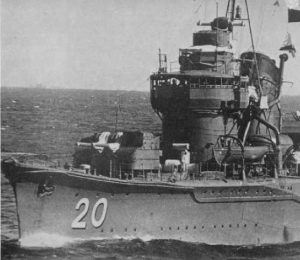
On December 24, 1941, K XVI sank the Japanese destroyer Sagiri near Kuching Bay. The K XVI also managed to damage the Japanese fighter Marakumo. It was the first torpedoing of Japanese warships in World War II. It would be the last action of the K XVI; the next day he was torpedoed 60 miles northwest of Kuching by the Japanese submarine I 66. All 36 crew members were killed, they are remembered at a memorial in the Netherlands.
The successes of the Dutch submarines were based on the way they organised their operations. They had trained their naval and air units to co-operate in a multi-layered defence of the Netherlands East Indies (NEI). First, the long-range Royal Netherlands Naval Air Service (MLD) reconnaissance planes would search and spot the Japanese invasion fleet. Then these planes would guide the RNN submarine wolf pack groups to the Japanese. Next the Royal Netherlands East Indies Army Air Force (ML-KNIL) bombers would attack the invaders. This would be followed by a conclusive sortie by the small Dutch surface fleet of light cruisers, destroyers, and motor torpedo boats. Like a jigsaw, the Dutch plan required all its pieces for complete success. When ABDA was formed the Dutch came under British command. They ordered solitary submarine patrols and the MLD planes were used for other operations. This was “particularly disastrous” for the RNN fleet as these planes were its eyes”. As a result, the British command contributed to the RNN submarine losses by ordering the Dutch submarines to patrol unfamiliar waters without providing air cover.
There were severe military losses during the Dutch assistance to the Allied Forces at the Battles of Singapore and Malaya. This had a negative effect on the defence of Netherlands East Indies.
Not enough resources left to defend Netherlands East Indies
After fighting the Dutch for 36 days, the Japanese formally declared war on the Netherlands East indies on 12 January 1942. The Japanese preceded it by attacking Tarakan (Borneo) and Menado (Celebes) on the previous day. Tarakan and Menado were the first, forlorn NEI battles, based on faulty ABDA strategy. The British had never believed that Singapore would fall. By the time the Japanese started to reach Java, ABDA was basically abandoned. ABDA did not keep to the promises made by the Brits and Americans that in case Singapore was lost and the Japanese would advance on NEI that they would send major reinforcements. At that stage the fight was largely left to Dutch and Australian forces. The situation only changed after the Allies regrouped in April that year under the Southwest Pacific Area (SWPA) Command of General MacArthur, by that time NEI had already been lost. MacArthur had to flee the Philippines and also arrived in Australia. He became the Commander of SWPA. He was humiliated by this escape and this later on also had an effect on the liberation of the NEI and the consequent geopolitical dramas that followed.
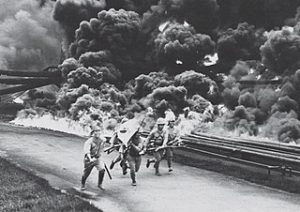
In the meantime, Tarakan’s 1,300 KNIL defenders, led by Lieutenant Colonel S. de Waal, comprised VIIth Battalion and two coastal batteries supported by patrol boat P.1 (23 tons), patrol launch Aida, submarine K-X and Prins Van Oranje (1,291 tons) that had just laid a minefield. However, without any follow up support they were fighting a losing battle. However, not before they had blown up the critical oil field installation at Balikpapan. Access to oil was one of the key reasons Japan wanted to conquer NEI. It did take the Japanese nearly till the end of the war to get the installation running close to capacity again.
The Japanese Eastern Invasion Force left French Indochina on 18 February. The next day, the Western Invasion Force departed the Philippines. ABDA’s HQ had known for five days via a telegram from MacArthur that a Japanese fleet was concentrated at Jolo in the Philippines. Had that information be made available they could have concentrated the submarines in the Makasser Strait to block a Java invasion. The loss 3 light cruisers (damaged and sent elsewhere), 3 RNN destroyers, 8 (5 RNN) submarines and numerous smaller warships in three months of constant battle had weakened Java’s naval defences.
On 1 March, the remaining four serviceable motor torpedo boats attacked the Eastern Invasion Force and returned to Soerabaja; submarine K-XV damaged the tanker Tsurumi (8,000 tons) in Bantam Bay while the US submarine Sailfish sank the aircraft ferry Kanogawa Maru (6,500 tons) off Bali. On 2 March RNN minesweeper Endeh (175 tons) was sunk battling a Japanese destroyer in the Java Sea.
The Fall Of NEI
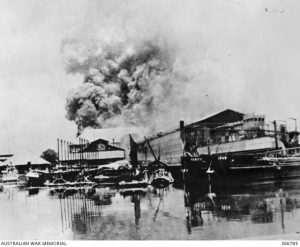
After the enormous Allied losses during the Battle of the Java Sea, it was clear that NEI would be lost to the Japanese RNN vessels were orderedto leave Java on March 6. Seven submarines, a gunboat, a minelayer, four minesweepers, a survey vessel and a fleet supply ship escaped. The 982-ton minelayer Krakatau and 460-ton minesweepers Jan van Amstel and Eland Dubois were lost in the attempt. Japanese destroyers had sunk auxiliary naval tanker BEN 2 (913 tons) trying to escape via the Bali Straits on 4 March.
On 8 March, the Japanese finally entered Soerabaja, to find it ablaze due to “the incendiarism carried out by the retreating Dutch troops.” The harbour was full of scuttled ships, including Soerabaia, Serdang, destroyers Stewart, Banckert, submarines K-X, K-XIII, K-XVIII, minelayer Gouden Leeuw (1,291 tons), 10 minesweepers, 5 patrol vessels and 13 motor torpedo boats. An unfinished sloop and 12 motor launches were destroyed on the stocks. Survey vessel Willebrord Snelluis (930 tons) was sunk as a blockship. Following his Governor-General’s advice, ter Poorten declared Bandoeng an open city and sent emissaries on the Bandoeng-Kalidjati Road towards the enemy.
The Dutch forces were ordered to surrender at 10 am on 9 March.
See also the story of Henk Paardekoper (in Dutch)
Dutch ships flee to Australia
With the Netherlands occupied by the Nazis, whatever could be salvaged from NEI arrived in Australia (and some of it in Ceylon). All government and military officials that could flee arrived in Australia.
The Dutch had one of the largest merchants fleets in the world and without a safe harbour in either the Netherlands or NEI they also ended up in Australia. They would become one of the largest logistic shipping forces, they were specifically praised for their role in the war effort by General MacArthur.
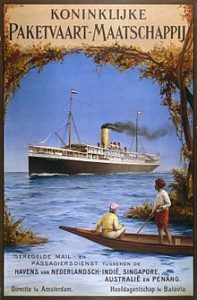 The majority of the Dutch merchant fleet was managed by the Koninklijke Paketvaart-Maatschappij – KPM (Royal Packet Navigation Company).
The majority of the Dutch merchant fleet was managed by the Koninklijke Paketvaart-Maatschappij – KPM (Royal Packet Navigation Company).
KPM transferred its headquarters to Australia to ‘Paketvaart House’ at 255 George Street, Sydney. Many KPM vessels escaping to Australia carried refugees including Allied servicemen. Abbekerk fled Tjilatjap crammed with 1,500 men, she reached Fremantle on 5 March 1942. Aboard Abbekirk were 15 Australian Army escapees from Malaya, who were impressed by the resolution and skill of her Dutch captain whilst under Japanese air attack. Zaandam made Fremantle on 6 March carrying mostly British evacuees.
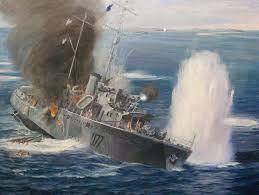
On 13 March, the steamer Tjimanoek (5,628 tons) brought to Fremantle 15 survivors from MMS 51 and Anking that had been part of the ill-fated HMAS Yarra convoy. Tawali (8,178 tons) saved another 57 survivors from Anking, reaching Colombo on 14 March.
The RNN submarine K-XI saved the only Yarra survivors, 18 ratings plus the fourth engineer from Parigi. One rating died en route to Colombo where K-XI docked on 17 March. K-XI gave Australia the first news of Yarra’s fate. K-XI crew’s action earned praise and added to the high reputation of the RNN (in comparison to the poor reputation of the KNIL, the NEI Army) with Australians. One Yarra survivor said that “no men in the world could have been kinder”, with similar sentiments expressed about the Tjimanoek‘s Dutch crew whose “kindness and hospitality … were beyond praise.”
Bantam reached Sydney via Fremantle from Soerabaja on 17 March 1942. The 9 metre Dutch lifeboat Scorpion reached Western Australia on 23 April. Fremantle was the destination for many of the NEI evacuation ships, as it was the nearest, major port on the escape route from Tjilatjap or through the Lombok Strait. So many Dutch vessels or warships were berthed at Fremantle by early March 1942 that the local wharf labourers labelled them the ‘The Flying Dutchmen’.
NEI’s new command in Ceylon nor the new NEI Commission in Australia, were sufficiently organised nor controlled enough planes or ships to evacuate the remaining KNIL units. Upon arrival in Ceylon on 3 March, command was taken of the surviving Dutch ships, planes and personnel who had escaped via the Lombok Strait to Trincomalee. These included the old cruiser Sumatra, submarines O-19, K-XIV, K-XV, gunboat/sloop Soemba, minelayer Willem Van der Zaan plus the Gouvernement marine’s supply vessel Zuiderkruis (2,612 tons) and survey vessel Hydrograff (297 tons). KPM’s Plancius (5,955 tons) was converted to a submarine depot ship.
The cruiser Jacob Van Heemskerk arrived on 6 March. Having been completed in Britain as an anti-aircraft cruiser, she had been sent to reinforce the NEI but arrived too late, as did the RNN auxiliary submarine depot ship Columbia (10,782 tons).
In Australia, there were the submarines K-VIII, K-IX, K-XI, K-XII, minesweepers Abraham Crijnssen and Merbaboe, Smeroe, Rindjani (all 80 tons) at Fremantle, the auxiliary oiler Claudius and cruiser Tromp, an assortment of Army, Navy and civil aircraft. Submarine officers Lieutenant A.M. Idema and Lieutenant R.J. Hordijk escaped from Hong Kong on 28 January.
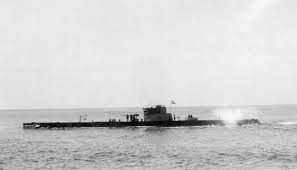
The submarines K-IX (521 tons) commanded by Lieutenant J. Brunsting, K-XII under Lieutenant-Commander H.C.J. Coumou (Royal Netherlands Naval Reserve) and K-VIII refitted at Fremantle where they came under the operational control of MacArthur’s submarine commander Rear-Admiral Charles Lockwood of the US Navy. Lockwood considered that as K-IX was 20 years old, it was obsolete. After it completed its refit in May, K-IX was ordered across to Sydney where it was to aid Allied destroyers in asdic training. K-IX sailed in convoy with K-XII and Abraham Crijnssen, with the latter two ships visiting Adelaide and Melbourne along the way. K-XII, after refitting in Sydney, returned to Fremantle to participate in operational patrols. Lockwood decided that due to the age of K-VIII, it should also be paid-off and scrapped on 27 August 1942. Her diesel engines were used to power a slipway while her hull was used on a Fremantle breakwater.
Re-organisation Dutch Naval Command in Australia
The re-organisation of the Dutch naval command to serve its ships based in Australia occurred soon after the fall of Java. On 10 March 1942, after discussions with the Acting Governor-General of NEI Hubert Van Mook, and Naval Commander Conrad Helfrich announced new appointments.
- The RNN established its HQ with Rear-Admiral Frederik Willem Coster’s HQ on St Kilda Road, Melbourne, with its naval barracks at 364 Beaconsfield Parade, St Kilda.Commander B.J. Knollema, who had been the Dutch Naval Control Officer at Singapore, took up a similar position in Wellington, New Zealand.
- Commander A. Haitsma (RNN Reserve) was brought over from Wellington to become the Dutch Naval Control Officer in Melbourne.
- Dutch Naval Control Officer to Australia Lieutenant-Commander Bloem had such “a multiplication of activities” that he had already been given an assistant Lieutenant C.J. Van Es (Royal Netherlands Naval Reserve) on 2 January 1942.
- Commander G.B. Salm, the Allied Consultative Shipping Council representative and RNN Liaison Officer in Sydney, had his staff increased to include Lieutenant-Commander H.J. Landsman, Lieutenant H. Gilles and Lieutenant Kruyswyk (all Royal Netherlands Naval Reserve).
- Lieutenant-Commander K.M.S. Wytema was appointed as the Dutch Naval Control Officer in San Francisco
The Dutch Naval Control offices were located at 475 Collins Street, Melbourne, 58 Margaret Street, Sydney and 334 Queen Street, Brisbane.
Japanese attack in Sydney Harbour
After the Fall of Singapore the Japanese moved on to the NEI. This defeat is also seen as the start of the final chapter of the British Empire.
The Japanese were fully aware that the Allies would use Australia as the base from where they would launch their military operation and from where they would supply their next stage of their war effort. Their raids on Darwin, Broome, Exmouth and Townsville need to be looked at from that perspective. The Japanese had no intention – at least not at this stage – to invade Australia.
The following event in Sydney also needs to be seen in that context.
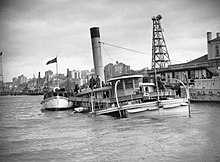
On 28 May 1942, the Japanese submarine I-21 launched a floatplane. It flew over Sydney Harbour spotting 13 Allied warships including K-IXl. On 31 May, I-22 released Midget No 21, I-24 released Midget M24 and I-27 released Midget No 14 for the raid. A major target was the heavy cruiser, USS Chicago. She was berthed beside the depot ship HMAS Kuttabul and K-IX at Garden Island’s south-eastern corner. At 11.25pm, Midget M24 fired torpedoes at Chicago. The torpedoes missed the cruiser and slammed into the harbour floor under Kuttabul and K-IX. The resultant explosion sank the depot ship; killed 19 Royal Australian Navy (RAN) personnel and destroyed storage battery jars on K-IX. K-IX was severely damaged and she was under continuous dockyard repair for the next two years. On 1 June, K-IX was towed up the harbour away from the wreck of Kuttabul. Post-raid publicity censorship instructed the press to make no mention of K-IX. This was to ensure that details of any RNN warships based in the SWPA were not passed onto the Japanese. Midgets No 14 and 21 were sunk in Sydney Harbour. K-IX‘s attacker, Midget M24, crossed the indicator loop, at 1.58am, on 1 June and disappeared. Its fate was a mystery until 2007. Amateur divers found its wreck on the ocean floor near the Hawkesbury River’s mouth (north of Sydney).
US Vice Admiral Herbert Leary ordered immediate air and naval patrols to find and destroy the enemy submarines operating off Sydney. The new No.18 NEI RAAF Squadron was dispatched on these anti-submarine patrols. The Royal Australian Air Force (RAAF) ordered its Commander Fiedeldij to send the squadron’s five Mitchells from Canberra to search off Newcastle.
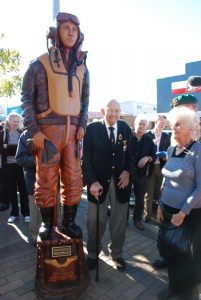
On 8 June 1942, it was announced in Australian newspapers that a No.18 Squadron Mitchell had sunk a Japanese submarine off New South Wales. The names of the Dutch aircrew were withheld for fear of Japanese reprisals against family who were POWs or internees. Lieutenant Gus Winckel, Broome’s sole defender on 3 March, piloted the Mitchell. It was fitted with the new Nordup bombsight that aided the attack. He discovered the submarine at 8am on 4 June. The sunken submarine’s position was recorded in the navigator’s log as: 35 22′ South, 152 36′ East on course 205 off Moruya, NSW. Yet a check of Japanese ship loss registers shows that all the submarines involved in the Sydney Harbour Raid were accounted for, with no Japanese submarine recorded as sunk off NSW. Winckel’s success is not mentioned in the official Australian War Histories. Too many sources exist for the sinking of a Japanese submarine by No.18 Squadron to be dismissed as a myth. The story of the sinking of the submarine is contained in the official Dutch War History and in No.18 Squadron Forces Association’s published histories. No.18 Squadron members Marinus Bakker, Jan Van Arkell and Gus Winckel retold the story to the author in interviews. Winckel recalled being driven to Parliament House, Canberra to explain to Curtin’s cabinet how the submarine was sunk. Bruce even delivered the Curtin Government’s message of appreciation over this Dutch military success in Australian waters to Queen Wilhelmina on 11 June.
The Western Australia Naval Defence Force
On 25 September 1942, Jacob Van Heemskerk, Van Galen and Tjerk Hiddes reached Fremantle. Australian specialists were assigned to them, with Van Galen receiving radar operator Darcy Keating. The ships were allotted to the area commander, Rear-Admiral Lockwood (US Navy – USN), who was a submarine officer. Tromp, Voyager and the light cruiser HMAS Adelaide left Sydney to join them. These seven warships comprised Lockwood’s major surface units for defending WA. With a large RNN presence in Fremantle, Rear-Admiral Frederik Willem Coster (RNN) had to arrange base support for his ships and sailors. In September 1942, Coster flew from Melbourne to Fremantle for a forces inspection. He was keen to meet Lockwood and to visit the K-XII. Coster was a submarine enthusiast, who had been responsible for the installation of air-conditioning in pre-war Dutch submarines, like the K-XII. Resulting from Coster’s visit, a Dutch Women’s Auxiliary Force was raised in WA from NEI refugees, some of whom were Broome Raid survivors. Many had husbands who were POWs so the women wanted to aid the war effort. Lockwood described the women’s feelings of frustration:
What had become of their menfolk, few, if any knew. The courage of these refugees under heartbreaking conditions and their determination to help in some form of war work was inspiring.
The Dutch Women’s Auxiliary Force’s enthusiasm created RNN base facilities at Fremantle that would be the envy of other Allied naval personnel.
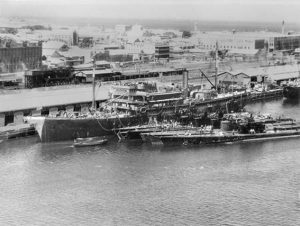
The K-XII the sole Fremantle-based RNN submarine fought a largely unheralded war. This was because the older K-XII was used either on secret missions for the Netherlands East Indies Forces Intelligence Service (NEFIS) or was under repair after the missions. Built in 1924, K-XII was nearing the end of its service life and experienced constant breakdowns. Repair delays occurred due the need to manufacture some spare parts that were unavailable from the Netherlands. This meant that K-XII was more often in dry dock than out of it. She sailed over from Sydney in August 1942 and was used for four NEFIS patrols until June 1943. On one such patrol, in November 1942, USAAF bombers attacked K-XII as she approached Fremantle. The bombers missed but K XII Captain Henry Coumou launched a protest. It was dismissed on the grounds of “failure to give the correct recognition signal.” Coumou probably thought the incident more a reflection of the poor ship recognition skills of US pilots. The RAN and USN would have agreed. Their warships had suffered USAAF attacks in the Battle of the Coral Sea in May 1942 and received the same USAAF denials
The Indian Ocean was divided between SWPA under US command and South East Asia Command (SEAC) operating in the Indian Theatre under British command. The Ceylon-based RNN submarines on patrol in this ocean saw much more action and were able to reduce the volume of enemy shipping entering SWPA. From 27 July to 11 September 1942, O-23 (888 tons, Lieutenant-Commander Valkenburg) sank two ships of 12,333 tons total and torpedoed another of 729 tons in the Malacca Straits. On a second patrol from 18 October to 8 November, O-23 torpedoed another ship (4,621 tons) in the same area.
Sydney-based K-IX became a training ship for the RAN
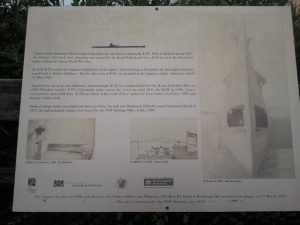
The submarine K-IX remained under repair after the Sydney Harbour Raid. The RAN was interested in K-IX for use in anti-submarine training for its locally built corvettes and frigates. On 15 July 1942, K-IX was decommissioned in the RNN. On 27 September, she was transferred on loan to the RAN. Although obsolete, K-IX was the only submarine to be commissioned into the RAN during the War. She provided valuable anti-submarine experience for new RAN ships and crew.
K-IX was badly damaged by a battery explosion on 22 January 1944. Due to a lack of spare parts the submarine was decommissioned on 31 March 1944, having spent only 31 days at sea. Following her decommissioning K-IX re-entered Dutch service as an oil lighter. It was washed ashore near Seal Rocks, New South Wales on 8 June 1945 while under tow to Merauke in Dutch New Guinea and subsequently stripped for scrap.
The remnants of K-IX were located on 20 July 1999 by the New South Wales Government’s Heritage Office. The beach on which it grounded and its remnants remain is known as Submarine Beach.
As a result of the long time spent in dry dock, K-IX was the subject of a painting by the artist Richard Ashwin. Tromp was also chosen as an artistic subject. Douglas Watson painted Tromp in Sydney in November 1942 and again at Williamstown, Melbourne in November 1943.
Participation in the Seventh Fleet
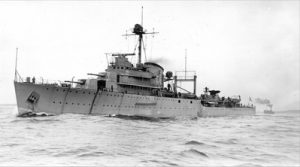
The 7th Fleetwas formed on March 15, 1943 in Brisbane, Australia, during World War II. It served in the South West Pacific Area (SWPA) under the control of General Douglas MacArthur, and the 7th Fleet commander also served as commander of Allied naval forces in the SWPA. This was the beginning of the now famous US Seventh Fleet. At its
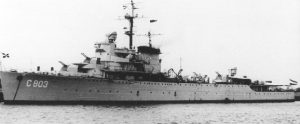
formation, it was a small, multinational force.
The new fleet comprised US, Australian and Dutch warships. Its heaviest surface units were cruisers (Chicago, Australia, Hobart, Adelaide, Tromp, Jacob Van Heemskerck).
Two-thirds of the cruisers were Dutch. The 7th Fleet included two RNN destroyers, two RNN submarines and a RNN minesweeper. A Dutch liaison officer Commander A.A. Fresco was appointed to the 7th Fleet’s staff in San Francisco.
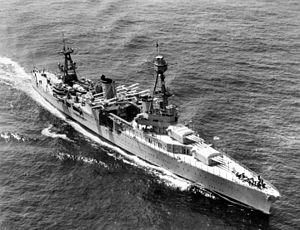

Most of that transport shipping for the fleet was done with Dutch merchant ships (KPM). General MacArthur specifically mentioned the effort of these Dutch merchants. The KPM came out of the war badly battered. She lost 96 ships, killing about 1,000 people.
However, although part of the 7th Fleet, there were few chances for the RNN to gain military glory as most of its warships were allotted to the Indian Ocean. After the Japanese carrier raid on Ceylon in April 1942, the Indian Ocean was a strategic backwater for both the Japanese and Allied navies. The warships at Fremantle were in an operational area where there was little opportunity to attack the enemy and retrieve Dutch military honour.
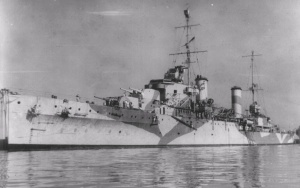
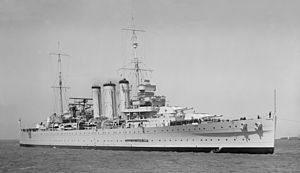
From September 1942 to January 1944, the RNN was largely occupied with the important but unspectacular task of escorting Indian Ocean convoys. The RNN warships were unable to act as independent units in pursuit of Dutch interests while under Lockwood’s control.
Only K-XII was used to exercise Dutch sovereignty, although covertly, via the NEFIS agents it delivered to the Occupied NEI. Few Australians know of the RNN wartime presence and that in late 1942 the RNN provided the bulk of the Allied naval strength guarding a vast area from Darwin to Perth. After 23 September 1942, when Voyager was lost, Van Galen and Tjerk Hiddes were the only destroyers left to Lockwood. It is ironical that the Dutch were called upon to defend the very shores where 300 years before, their ships had been driven onto reefs, thereby contributing the first pieces of knowledge about Australia.
Submarines used by the intelligence services
Once the Dutch become more settled, they and the Australians found that they shared common ground over their lack of influence upon Allied planning for the Pacific War. The Casablanca Conference of 14 to 25 January 1943 proved this. Admiral King argued against an invasion of the NEI in 1943 because of the strong Japanese garrisons there. He preferred to limit action in the NEI to submarine attacks on Japanese oil tankers and his views were incorporated into the Allied War Plan adopted on 22 January. MacArthur’s only directive regarding NEI operations was his support for a submarine campaign against enemy shipping in NEI waters, directed from Fremantle by Rear Admiral Lockwood
Only K-XII was available. K-XII became increasingly unreliable. To be serviced, it required some Dutch spare parts and these were unobtainable. K-XII went into drydock for a major overhaul in May 1943. Until it was finally retired on 12 April 1944, this submarine was to spend more time under repair than on active service. So NEFIS became dependent upon US submarines when, and if, they could be made available, as the Americans’ priority. As mentioned before, General MacArthur’s personal priority lay in intelligence and guerrilla operations in the Philippines and not in NEI. He felt humiliated that he had to flee during the Japanese invasion of the Philippines.
After the American successes at the Midway Islands, the Japanese were pushed back. MacArthur had set its eye on Dutch New Guinea (DNG) as from here he could make the jump to the Philippines.
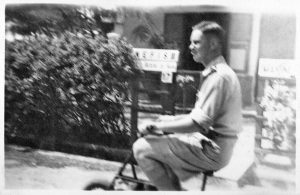
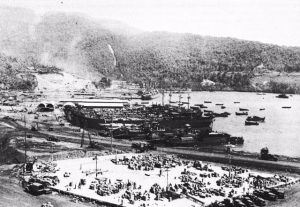
Here he could use the Dutch to gather intelligence about Japanese positions, troop movements, military installations and so on. However, with the Netherlands occupied the Dutch in SWPA had a continuous shortage of staff and resources. Due to the urgent need for information on Hollandia (Capital of DNG), where he wanted to establish his next staging camp, MacArthur ordered the Allied Intelligence Bureau (AIB) to work with NEFIS to establish a combined party to infiltrate Hollandia. After much toeing and froing this was organised, it comprised of Australians with NEFIS providing an interpreter Sergeant Launcelot. The US submarine Dace delivered the 12-man party led by Captain ‘Blue’ Harris to Tanahmerah Bay, 30 miles west of Hollandia, on 23 March 1944.
The use of submarines for other intelligence missions was as usual hampered by repairs and maintenance, a lack of spare parts and a lack of personell.
With K-XII unusable, K-XIV (998 tons, Lieutenant-Commander J.F. Drijfhout van Hooff) was sent to Australia for NEFIS use. After a US refit, K-XIV sailed to Australia in April 1944.
K-XV (998 tons, Lieutenant-Commander C. W. Th. Baron van Boetzelaer) was meant to accompany K-XIV but remained at Ceylon due to defective batteries.
The Dutch had asked that, as their submarines were to be used exclusively to support NEFIS, then the submarines should be placed under RNN Rear Admiral Koenraad rather than under MacArthur’s direct operational command. The Americans refused as it would have upset protocol but they were prepared to accept Koenraad’s administrative control of K-XIV.
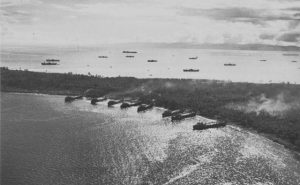
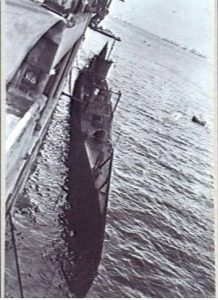
K-XIV undertook its first NEFIS patrol in June. On 21 June she torpedoed the minelayer Tsugaru (4,400 tons) in the boiler room. The US submarine Darter finished off Tsugaru on 29 June. On the same patrol, K-XIV sank a Japanese landing craft near Sanana in the Moluccas. During July and August 1944, K-XIV transported NEFIS missions around Morotai and Sorong. Koenraad’s only other submarine, the obsolete K-IX, was given back to the RNN by the RAN on 31 March 1944. She was converted into an oil hulk.
The submarine K-XIV dropped the NEFIS secret mission code named ‘Apricot’ party of Sergeant Manopo and four others into Celebes on 5 January 1945. After the Japanese captured Manopo, the rest of ’Apricot’ was evacuated on 31 January.
Lieutenant J. Tahija led the NEFIS secret mission code named ‘Firtree’ party (7 men) that landed from K-XV at Medio, Ceram in late 1944. ‘Firtree’ collected information about Ambon and the Soela Islands before evacuation.
This period marked the return of NEFIS operations to Java when the NEFIS secret mission code named ‘Goldfish 1’, led by Lieutenant De Haas with 8 Indonesians, left Australia in October 1944. Taken by submarine as far as the Paternoster Islands, located in the Makassar Strait off the east coast of Kalimantan (Borneo), between it and Sulawesi (Celebes) and closer to the latter island. Here they commandeered a prahoe. It took them to East Java where De Haas and one Indonesian landed but were captured and executed by the Japanese.
K-XII ended up in Luna Park, Sydney
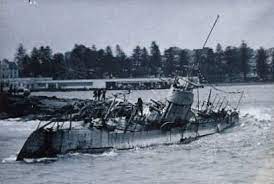
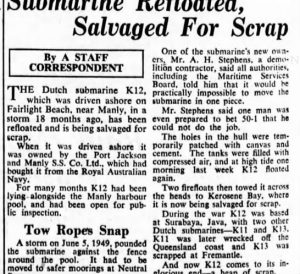 Used for NEFIS patrols until June 1943, the submarine K-XII had been become so unserviceable that it was relegated for use as a target ship for training for the Admiralty’s Anti-Submarine Division (ASDIC) by Allied planes and ships. These exercises further damaged K-XII. On 22 March 1944, the submarine sailed from Fremantle to Sydney to await its fate.
Used for NEFIS patrols until June 1943, the submarine K-XII had been become so unserviceable that it was relegated for use as a target ship for training for the Admiralty’s Anti-Submarine Division (ASDIC) by Allied planes and ships. These exercises further damaged K-XII. On 22 March 1944, the submarine sailed from Fremantle to Sydney to await its fate.
In September 1944, K-XII was stricken from the RNN list and sold to Australian businessmen who wished to use the submarine at Luna Park, Sydney. K-XII became an attraction, with the public paying to look through its periscope and inspect its engine room. Only one of its two engines was salvageable and, with the submarine’s generator, they were used for emergency lighting at Luna Park.
After a storm in June 1949, the sub was towed to less exposed waters but the towline broke and the sub drifted ashore at Fairlight. It remained there for 18 months before being salvaged and cut up for scrap in 1951.
Dutch successes with British submarines
By 1944 the RNN had finally received substantive reinforcements. These came from a British request to transfer some Ceylon-based submarines to Australia. On 31 January 1944, the British told USN Admiral Ernest King that by “the latter half of 1944 the number of British submarines in Eastern Theatre will be in excess of that which can usefully be operated against targets in the Malacca Strait”. It was the only viable submarine hunting ground left within South East Asia Command (SEAC).
The British proposed to send a submarine group to work with Rear-Admiral Lockwood’s flotilla at Fremantle so as to expand British patrols into the China and Java Seas. King approved this proposal. He did so on the understanding that the SEAC submarines would be placed under the operational control of the SWPA Commander MacArthur.
The British had to supply a depot ship, as Fremantle was barely able to service the Dutch (K-XIV) and USN submarines based there. The Exmouth Gulf advanced submarine base was often closed due to poor sea conditions.
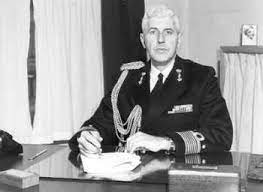
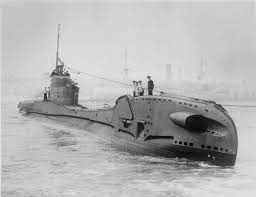
The British chose to send the 8th Submarine Flotilla. It comprised Zwaardvisch (1,170 tons, Lieutenant-Commander H.A.W. Goossens), O-19 (998 tons, Lieutenant-Commander A. Van Karnebeek) plus nine Royal Navy submarines. Zwaardvisch was the ex-British T-class submarine Talent that with Tijgerhaai (ex-HMS Tarn) were transferred to the RNN to replace the severe RNN submarine losses. Zwaardvisch arrived at Fremantle on 7 September 1944. The RNN submarine O-19, after a refit in Britain, reached Fremantle on 18 September 1944.
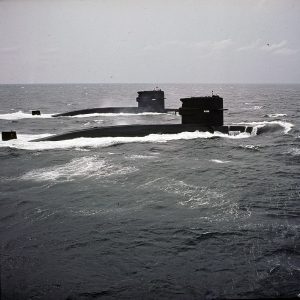
The RNN submariners were aware that they had to prove themselves to their successful USN counterparts, who “were not entirely convinced of the British [and Dutch] submarines’ battle-worthiness.” USN concerns over RNN submarines’ seaworthiness derived the poor serviceability rate of K-IX, K-XII and K-XV. It was a particular concern of King who had stipulated on 26 August 1944 that the RNN submarines would be allowed to transfer to Fremantle provided that an “adequate spare parts supply is furnished by the Dutch Government” and that “a Dutch submarine depot ship should be provided if one is available.” No RNN depot ship was available.
KPM’s Plancius which had been converted to a submarine depot ship had to remain at Ceylon to service O-24. The other submarine depot ship the former Shell oil tanker Ondina was a ‘stop-gap’ depot ship allotted specifically to Exmouth Gulf.
The Royal Navy’s depot ship HMS Maidstone was sent to service all the 8th Flotilla submarines. A RNN shore depot, commanded by Lieutenant-Commander Kolling, was established at Crawley Bay, Fremantle. The US view of the Dutch-built submarines’ unreliability did not apply to the Dutch crews. Lockwood welcomed the additional RNN submarines, stating that from past experience he believed that:
Their crews were hardy and determined … and [being] not so well equipped for habitability and comfort [their submarines] were thoroughly effective. The skippers handled their boats with great skill and need take off their hats to no-one, with respect to daring in making their attacks. I became acquainted with … Dutch submariners…. My observation of their capabilities and their performance in the Southwest Pacific, merely confirmed my former high regard for their hardihood and fighting qualities. When there’s a tough job to be done, I’m ready at any time to team up with a … Dutchman.
For the British of the 8th Flotilla, the Dutch submariners were an interesting contrast. The British noted that the RNN submarines suffered from a shortage of officers as illustrated by the RNN submarine officers being “all men commissioned in peace time and consequently older and more serious-minded than their [British] counterparts.” Not that this serious-mindedness stopped the Dutch from possessing what the British believed to be the best submarine mess at Fremantle at the Ocean Beach Hotel, Cotesloe. Alistair Mars who served on the submarine HMS Thule noted that while the USN submarine mess was well stocked with provisions:
…the Dutch submarine mess …well they had everything…. I embarked on a mad round of the …latter [bottled gaiety] … to the Dutch officers mess where hospitality was staggering.”
RNN submarines divided patrol areas. Zwaardvisch patrolled the South China Sea. O-19 patrolled the Java and Flores Seas and the Malacca Strait. Leaving Fremantle, they sailed north along the coast until they reached Exmouth Gulf to refuel from Ondina. The submarines entered Lombok Strait between Bali and the Lombok Islands. It was a hazardous spot as the Japanese defended the Strait with anti-submarine patrols and coastal guns plus there it had a nasty south-running current. Alternative routes were available via Ombai Strait between the Alor and Ambeno Islands, or through the Timor Sea. Allied submarines preferred Lombok Strait for it was wider and was not heavily mined. Lombok Strait’s currents had the advantage that when “returning from patrol, of course, a submarine merely had to dive at the northern end and be sucked southwards by the current and shot into the Indian Ocean.”
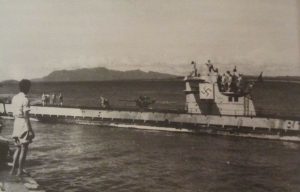
During its first patrol, Zwaardvisch sank a 500-ton Japanese tanker on 4 October 1944. On 6 October, Zwaardvisch scored the 8th Flotilla’s most notable success when Goossens sank the German submarine U-168 (1,140 tons) in the Java Sea. Upon surfacing, Zwaardvisch rescued 27 survivors. Due to the danger posed by so many German POWs being inside the cramped submarine, Goossens seized a passing prahoe and placed 22 POWs aboard. Captain Helmut Aich, his three officers and a badly injured German were kept on Zwaardvisch to go to Fremantle.
Zwaardvisch‘s success was the envy of the other 8th Flotilla submarines such that “although nobody equalled Goossens’ feat of sinking a U-Boat, it was not for want of trying.” On 10 October, Zwaardvisch sank the motor ship Koei Maru (19 tons) and then Kaiyo Maru No 2 (143 tons) on 15 October. On 17 October, Goossens added to his score by sinking the minelayer Itsukushima (1,970 tons) and damaging her sister ship Wakataka. At the northern entrance to Lombok Strait, Zwaardvisch was severely damaged by depth charges from two Japanese patrol boats on 5 December. With a cracked telemotor and both periscopes inoperable, Goossens abandoned his patrol but not before rescuing Balinese fisherman Tima Oemar who had strayed off course.
Tima was delivered to Darwin where Lieutenant Van De Woude (RNN) interviewed him for NEFIS on 12 December 1944. Zwaardvisch damaged a Japanese merchantman on 8 February 1945. It was Goossens’ last success before Zwaardvisch was recalled to Europe where it returned to the British in May 1945. It was replaced by K-XI (611 tons, Lieutenant-Commander P.G. De Black). When K-XI reached Fremantle, it was found to be too obsolete for operations and was decommissioned on 11 April 1945.
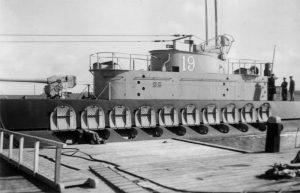
O-19 had its first success on 16 November 1944 sinking Kaishin Maru No 2 (150 tons) in the Java Sea. O-19 laid a minefield in Bantam Bay, Java where another merchantman was sunk. Alerted to the presence of O-19, Japanese patrol craft sought and depth-charged her, causing severe damage. While under repair at Fremantle, there was a change of command. Lieutenant-Commander J.F. Drijfhout van Hooff transferred from K-XIV to replace Lieutenant-Commander Karnebeek on 16 December. Command of K-XIV was given to Lieutenant-Commander J. Smith. Resuming patrols, O-19 sank the converted gunboat Shinko Maru No.1 (934 tons) on 9 January 1945. Soon after, O-19 torpedoed an unidentified vessel of 3,000 tons off Cape Poeting, south of Borneo. As a result, the submarine received another battering from depth charges, forcing its return to Fremantle.[1] On 10 April, O-19 sank the tanker Hosei Maru (896 tons) in the Java Sea. On 13 April O-19 laid 40 mines in the Banka Strait. On 22 April, Van Hoof scored a major success in damaging the heavy cruiser Ashigara (12,000 tons). On 19 April 1945, the 8th Flotilla was reorganized. Maidstone and six British submarines went to Subic Bay in the Philippines. HMS Adamant arrived in Fremantle on 11 April 1945 to serve as the depot ship for the remaining submarines, reorganised into the 4th Flotilla. The 4th Flotilla was allotted to the British Pacific Fleet that was operating within the SWPA.
Of Koenraad’s minesweepers, Merbaboe and Smeroe were stationed at Merauke in SE DNG, the only area not occupied by the Japanese it was used as an staging post early in the war. Rindjani had a refit at Port Moresby before being sent to Hollandia. He minesweeper Abraham Crijnssen was kept in Australia where it was relegated to a training ship for Indonesian recruits. Abraham Crijnssen’s permanent core of Dutch crew became so settled in Melbourne that it was reported in a local newspaper that 22% had married Australians.
A NEI Forces Canteen was established in Bourke Street, with activities run by the Roemah Indonesia Entertainment Committee. Some recruits sent to Melbourne were fishermen taken by O-19, K-XIV, K-XV and Zwaardvisch while on patrol. To dissuade Indonesian collaboration with the enemy and with the Japanese using prahoes, RNN submarines attacked all fishing vessels and took their crews. Nine prahoes (Kota Marino, Vierge, Tongkang etc.) and the merchantman Akegata Maru lost crews in this way. For example a RNN submarine captured two Indonesians sailing a prahoe in the Dampier Strait on 24 April 1944. On 23 June 1944, the prahoe Doenia Baroe was sunk near Pasi Ipoh. Its crew, Captain Soeliman Asik, Kasim, Saptoe Orbo and Koengkoe Hadji, were put aboard a RNN submarine. Captured fishermen were taken by K-XV to Ceylon or by the other RNN submarines to Darwin. NEFIS interviewed the fishermen for information on conditions in the Occupied NEI. They then ‘volunteered’ for the RNN or the Dutch merchant marine. Such were the desperate measures to which the Dutch had to resort to cope with their personnel shortage.
Jan Leenhouwers – sailor on the Zwaardvisch
| Johan Cornelis Leenhouwers was born in Tilburg on the 27th November 1919, out of wedlock. He was formally adopted into the marriage of his mother to another gentleman on the 26th of November 1921.
He joined the Dutch navy before WW2 as an electrical mechanic on the submarines and I believe the submarine he was on, was one of the last to sail out of Holland as the Germans over ran Holland. He spent time in the UK before his submarine sailed to Columbo. From Columbo the submarine he was on then relocated to Fremantle for the later part of the war. I believe my father was transferred from his submarine that was about to sail to the US for a refit to another Dutch submarine. My understanding was that this was due to my fathers’ insubordination to his commanding officer. My father married an Australian woman and after the war, they relocated back to Holland. The family them emigrated to Australia with my father and older brother (born in Holland) arriving in Perth on February the 4th 1949. See additional link https://immigrantships.net/v5/1900v5/volendam19490204.html I have recollections of WW2 stories that my father told me, however these are rather vague as dad never really went into any details. I know my older sister would have additional information; however, I hope this may be enough to start with at this stage. I do have some of his documents and medals in my possession and will endeavour to locate them for reference. Peter Leenhouwers (his son) |
The end of the story
With the surrender of the Japanese in August 1945, the submarine operations came to an end. The above-mentioned stories, however, clearly indicate the important role that these ships played during the various phases of the war, this despite the technical problems they faced and the ongoing shortage of navy personnel.
By that time there were only four of the original 15 NEI submarines (K-VIII, K-XIV, K-XV, O-19) left, plus the two later, ex-Royal Navy reinforcement boats. Due to intensive use across the Far East during 1941 to 1945, the four, pre-war submarines were in bad shape.
The fact that the fleet consists of different classes was also a problem. It made maintenance and exercise of crews very costly. Because of the poor economic condition of the Netherlands after the war and the high costs caused by operations in ‘the East’, there is no money left for new construction. In other words, the future of the service did not look bright. Eventually, the navy succeeds in taking four submarines on loan from the British and the Americans.
Paul Budde (2022)
A personal story
Elsewhere we cover the story of Henk Paardekooper.
Two friends of the family lost their lives in Dutch submarines in the war with Japan:
Joop van de Klift died on the O-16.
Kees Prins with – as it turned out – the last Dutch submarine, which went down in the war.
At the last meeting, of several of them during the war, Kees told Henk Paardekoper: he was convinced that this would be his last trip and he left his paybook and some silverware with Henk in Brisbane. This was after the war given to his parents in the Netherlands. Henk’s daughter Henny was present and has a ‘Djokja’ silver basket, which Kees’ parents gave back in gratitude to Henny.
Hette Kingsma (Henny’s husband)
